Out of the Blue

“out of the blue” is the third part of an ongoing series of works that began with two camera-activated installations entitled, “Always.” “Always” is experienced at night and is an individual experience, whereas “out of the blue” is made in the direct sun and is a collection of panels that represent a period of time. “out of the blue” consists of a series of Photogram Cyanotypes on paper, hung in a timeline fashion.
Photograms are in essence a medium of light. This camera-less photography is created using objects that are laid directly onto sheets of photosensitized paper, which are then exposed to direct sunlight. The image mirrors the objects with a direct 1:1 relationship and is made through an act of physical correlation between subject and image. The image, a silhouette, is made of the gradient between light and shadow as forms are erased to white in the shadows, and grow to a brilliant blue in the light. There is a reversal in the process of exposure, in which the flat objects become spatially manifested on the page and spatial objects become flattened as they are imprinted on the surface they touch.
This work is blue (Prussian blue) because it is also a cyanotype. The blue is an outcome of a chemical reaction that is light sensitive– when exposed to light the chemical compound turns blue. Prussian blue was first synthesized about 1704 and was one of the first chemically created pigments. Historically, cyanotypes were used for scientific records of the natural world and architectural blueprints. The cyanotype aided in close looking and understanding.
“out of the blue” can be located within the tradition of other artists who have used photograms, from the layered, overlapping personal processes used by May Ray to the futurist works of László Moholy-Nagy and Lucia Moholy and the use of the figure in work by Maurice Tabard and Robert Rauschenberg. All four artists fluctuated between the abstract and the representational in their use of the photogram while also manipulating one’s sense of gravity and time as a way to disorient the viewer’s sense of perspective. As a painter working in photography, I am interested in what the medium dictates as described by Andre Bazin, “The photographic image is the object itself, the object freed from the conditions of time and space that govern it. No matter how fuzzy, distorted, or discolored, no matter how lacking in documentary value the image may be, it shares, by virtue of the very process of its becoming, the becoming of the model of which it is the model”.
These works use positive and negative objects, transparency and sequencing, overlap and repetition. The images you see in the work are made by moving, shaking, flipping and arranging the object on the paper quickly while it exposes in the sun. This alchemical process of shadow and light forces the work to be unseen while it is made, and each work becomes its own struggle with time and conditions. The work echoes the patterns created for Always and Always CMA in addition to other visual language derived from live action photography harvested online of competitive wrestling and the roman archway that are a mainstay for the artist.
How long a form stays in the light determines its presence on the work. The longer the objects are in the light, the more its presence will be held in the work. This work is a reminder that we can hold in the light that which we wish to expose and outline, but that this takes balance, risk, trial and error, as well as time and consistent practice. The longer something is held in the light, the more it will belong there. What do you hold in the light?
“out of the blue” Melissa Vogley Woods, Cyanotype Photogram Series, each paper panel is 18 x 24 inches, 2020. On view at the Hammond Harkins Gallery, June 2020-21
Distance Loop Installation
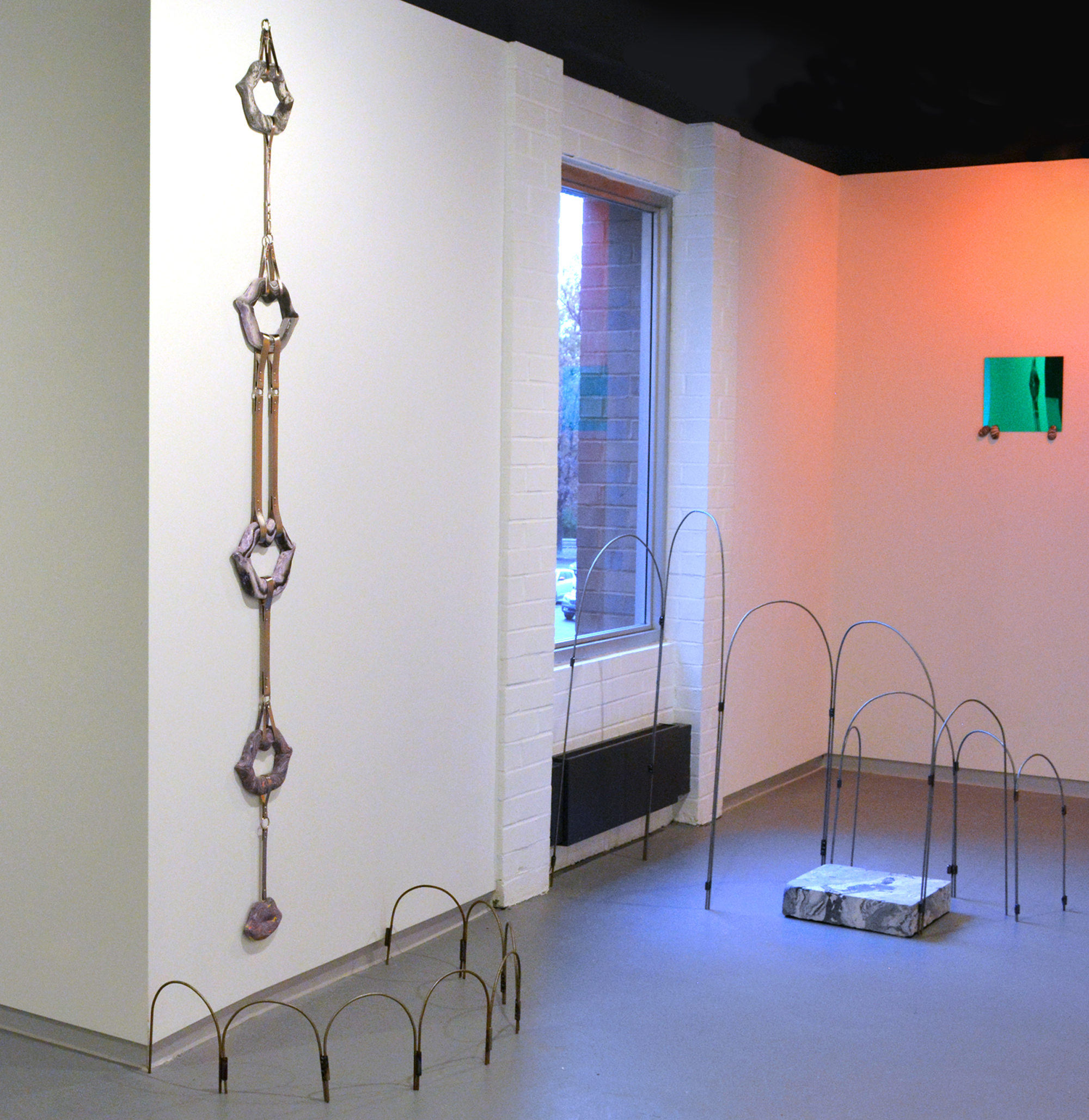
Distance Loop is configured like a cloistered garden. The viewer is invited to wander and circle around the partially lit and schematic space. Sculptural and installation elements keep the visitor meandering slowly as if they are strolling along an unfamiliar path. Objects are installed at various heights from floor to ceiling causing the visitor to look up and down as they walk. This can be disorienting, there are many reflective components that also slow the gaze. Areas of focus and dispersion occur, with singular objects isolated and others clustered like an overgrowth. Individual elements reference alcoves, open views, flower beds, gazing pools, or lone trees and ruins. Half the gallery’s atmosphere is dimly lit but holds many color casts, shadows and reflections- disrupting the viewer’s “natural” “naked” vision. How do we collect and live with that which has grown inside us? How and why do we tend gardens that were handed down to us with or without intention? How do we leave the gardens behind? How to start our own garden? What is our own?
I am fascinated by what becomes “history” as it is spoken and known and in this case, familiar history. How this is manifested internally and externally. I use largely abstract means because I am interested in subtleties of sideways, indirect and covert messages; the kind that are forced to be this way due to external powers, silencing and erasure.
Kent State Stark, Canton Ohio 2019
Always Installation on Residencial House
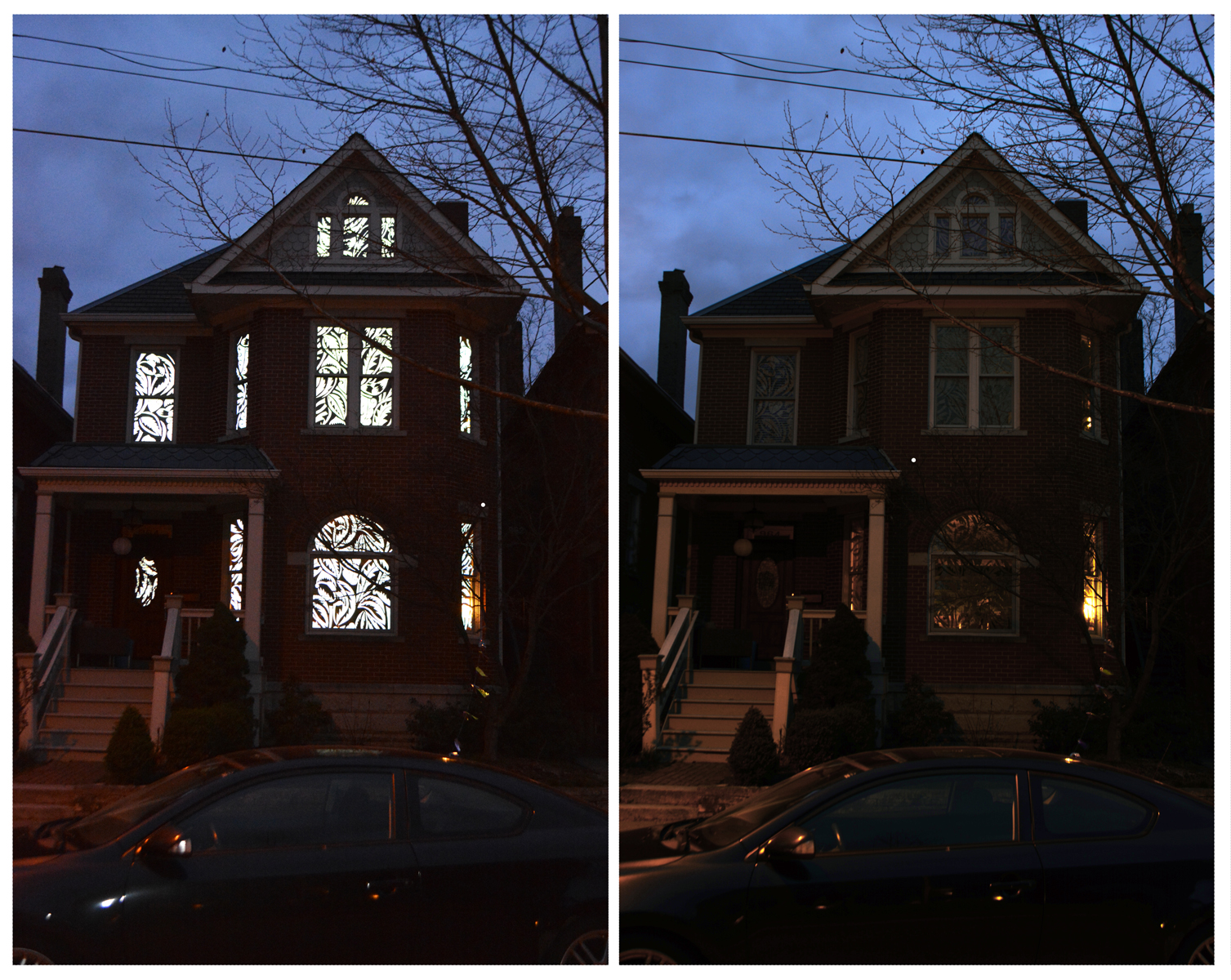
ALWAYS
Drive-by / walk-by interactive artwork by Melissa Vogley Woods March 31, 2020-
964 Neil Ave, East side of the street, Columbus, Ohio 43201
Reproduction of textile fabric designed in 1920 — the year the Spanish Flu ended –by the artist Raoul Dufy.
This work is best viewed at night or dusk and is activated by the passer-by through the use of a flashlight or flash photography.
~ Always will be on view until social distancing ends.
This design was created at the very end of the last pandemic of this nature in 1920. The re-vision of this pattern helps remind us to imagine that this, too, shall pass. Patterns can be comforting and intimate as well as emblems of human memories. The design created by Dufy comes to us from the past and a moment of relief and renaissance that is striking, beautiful and joyous. It has been placed in the windows to highlight that we are still connected even though temporarily separated from one another.
The house acts as a holding space for us and a framework for time as we move away from the linear into a more rounded, looping, circular sense. The house in this condition offers us both safety and menace. The windows are the space in between these: an exit to look out, the place between private and public.
Thinking about this pattern, this looping sense of time, this occurrence, and this cycle reminds us that this is a condition we have found ourselves in before and will again. That we will get past this time, because we have before. “An epidemic is at once biological and cultural, that possesses a standard dramaturgic narrative and that is structured by denial, recognition, action and reflection on the epidemic experience*” O ur new normal is a condition that humanity has cycled through many, many times.
The work is in essence, a reflection of light. The light is a phantasmagoric presence only seen when activated by light brought to the surface. In this way, the enduring aspect of this temporary art installation will be held by those who have visited the work. The viewer will hold the image in memory or in an apparatus and is the final step to the work’s function. The viewers’ actions are needed to make the work. This work changes depending on how you view it — with a flashlight, with a flash photo… the image will come to you.
The title comes from the words of the artist, Lee Krasner, when speaking of the seemingly unending condition women are held in relationship to men.
She summed it up in a single word. “Always”
Always, we will go through these moments
Always, we will find ways to continue…
Always CMA
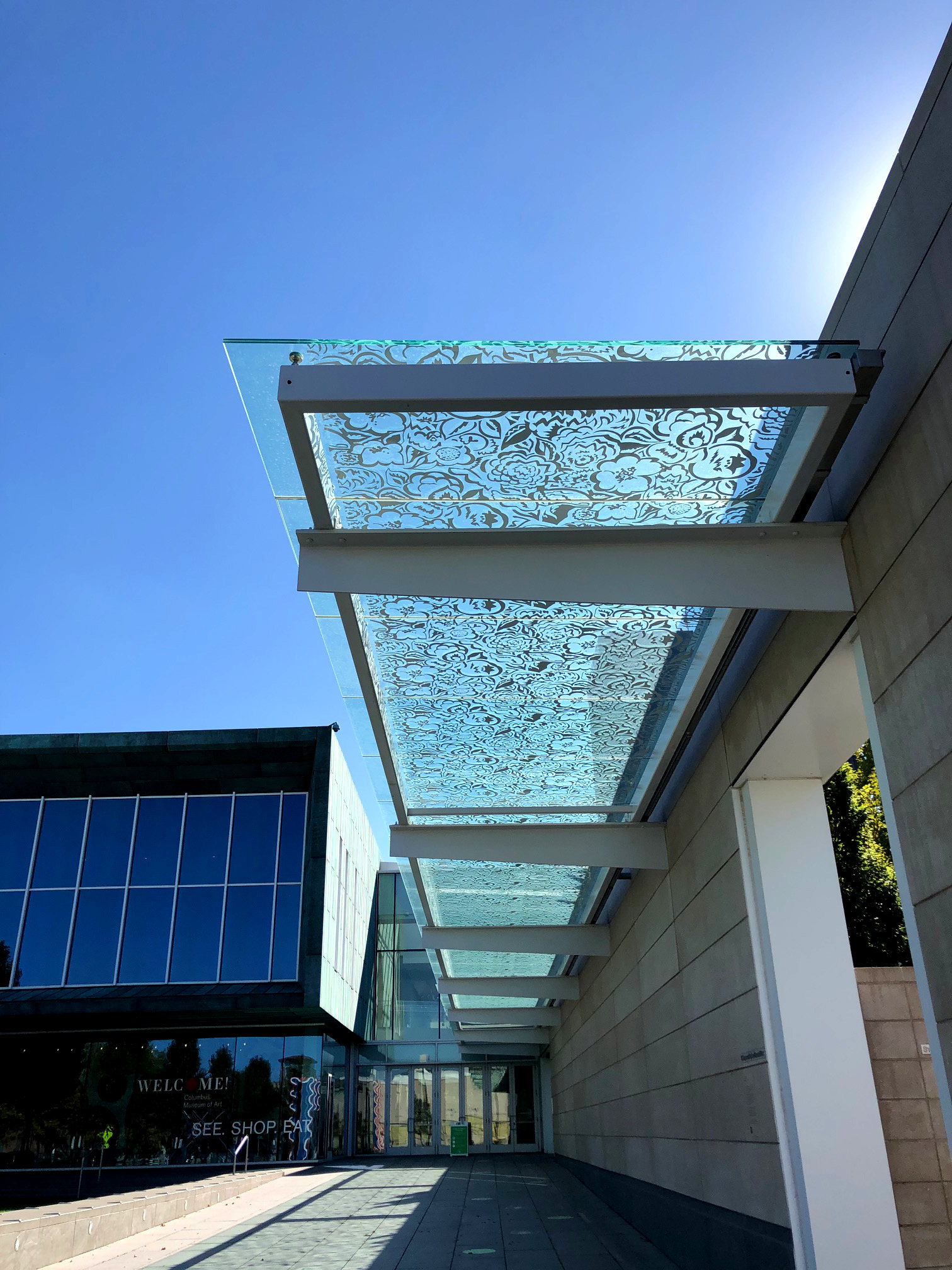
Melissa Vogley Woods
American, b. 1968
Always CMA
2020
Always CMA is a photo interactive artwork by Columbus-based artist Melissa Vogley Woods. The work is fabricated from engineering grade high-intensity reflective vinyl, and stretches along the glass overhang above the pathway to the entrance of the Columbus Museum of Art
In 1919, just as the Spanish flu was ending, Louis Bouché painted Still Life with Flowers—a beautiful depiction of colorful, lively flowers. Bouché’s painting was gifted to the Museum by Ferdinand Howald in 1931, as part of a large collection of American and European Modernism that became the foundation of its collection. Nearly a century later, in the midst of a different global pandemic, Vogley Woods re-envisioned Bouché’s painting as a radiant reminder that even the most challenging moments, too, shall pass.
Throughout the day, the piece creates a dynamic web of shadows that move and stretch like a sundial. However, visitors are strongly encouraged to visit the piece at night, when they can co-create the most luminescent version of the artwork. In the dark, the pattern must be “activated” by the viewer through the use of cell phone flash photography, or cell phone flashlight. Once the light source hits the work, it becomes incandescent, shining back at the viewer from her particular vantage point.
Each digital image of the work is distinct, and viewers can share their unique versions of the work by using the hashtag #alwayscma. QR codes on the work’s signage will connect visitors to interactive elements and to additional background information about this project.
Exterior of the Columbus Museum of Art semi Permanent Light bases Installation 2020
Well seen becomes sight and Song Itself
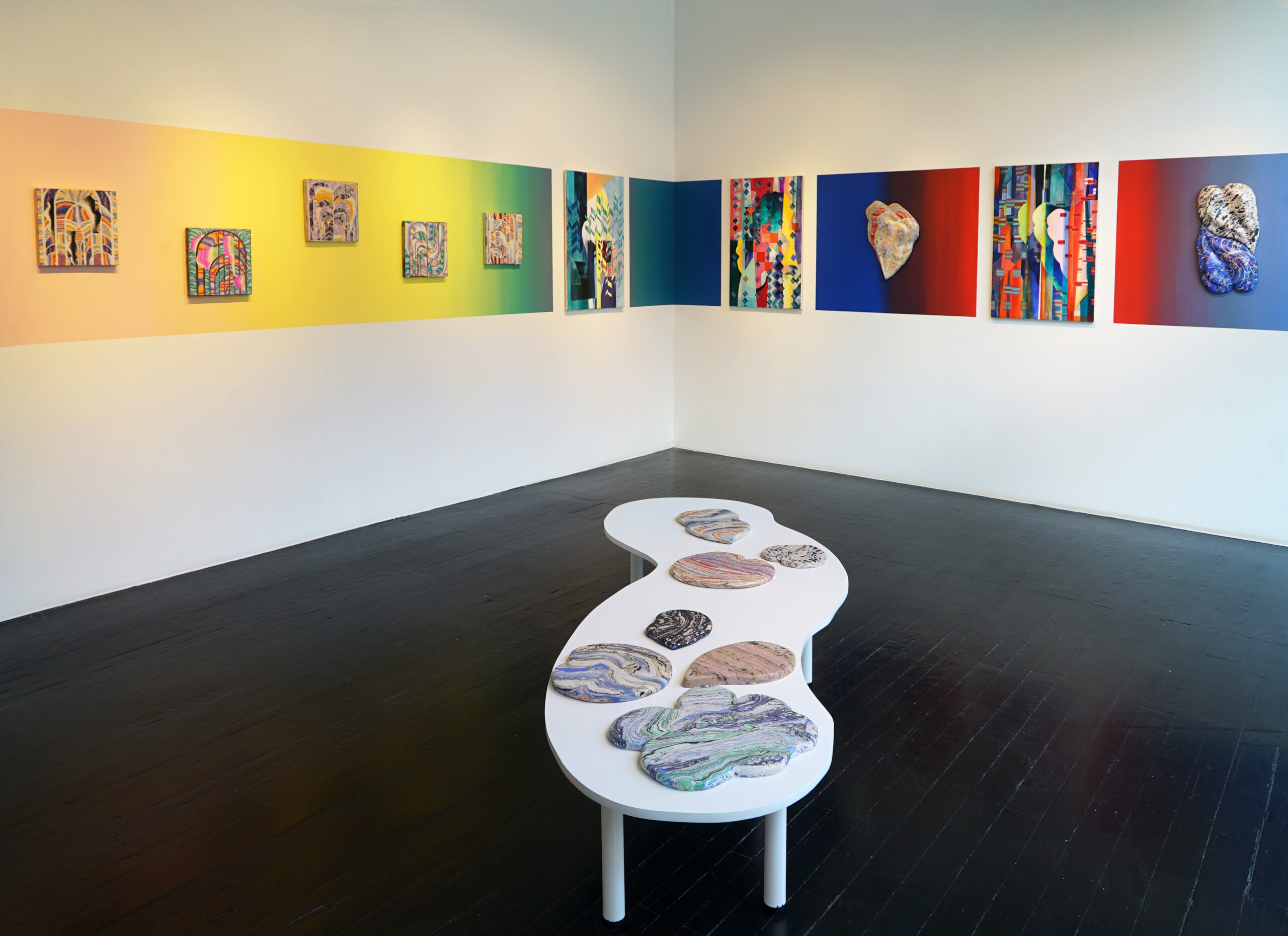
Well seen becomes sight and song itself is an exhibition of paintings, sculptures, and mural work that borrows from several artworks of Modernists Charles Sheeler and Morton Schamberg. I am specifically interested in how a set of still lives the two artists painted in 1918 in their shared studiohold many articulations and complexities around relationships, shared time, and conflict. I use two similar still lives to explore confluence, detachment, and correlation. The work in this exhibition consists of interlocking and repeating patterns. Each piece commemorates a story of time in a maze of color that mimics the accredited layers of sedimentary stone. The paintings are camouflaged tableaus that convolute the eye as if the layered moments have fused and become translucent. In my work, I reclaim historical production to dispel the ideas that history is in the past; it instead reverberates and repeats, staying with us, and we carry it in ourselves and through generations.
Hammond Harkins Gallery, Columbus Ohio 2022
Still Bodies detail
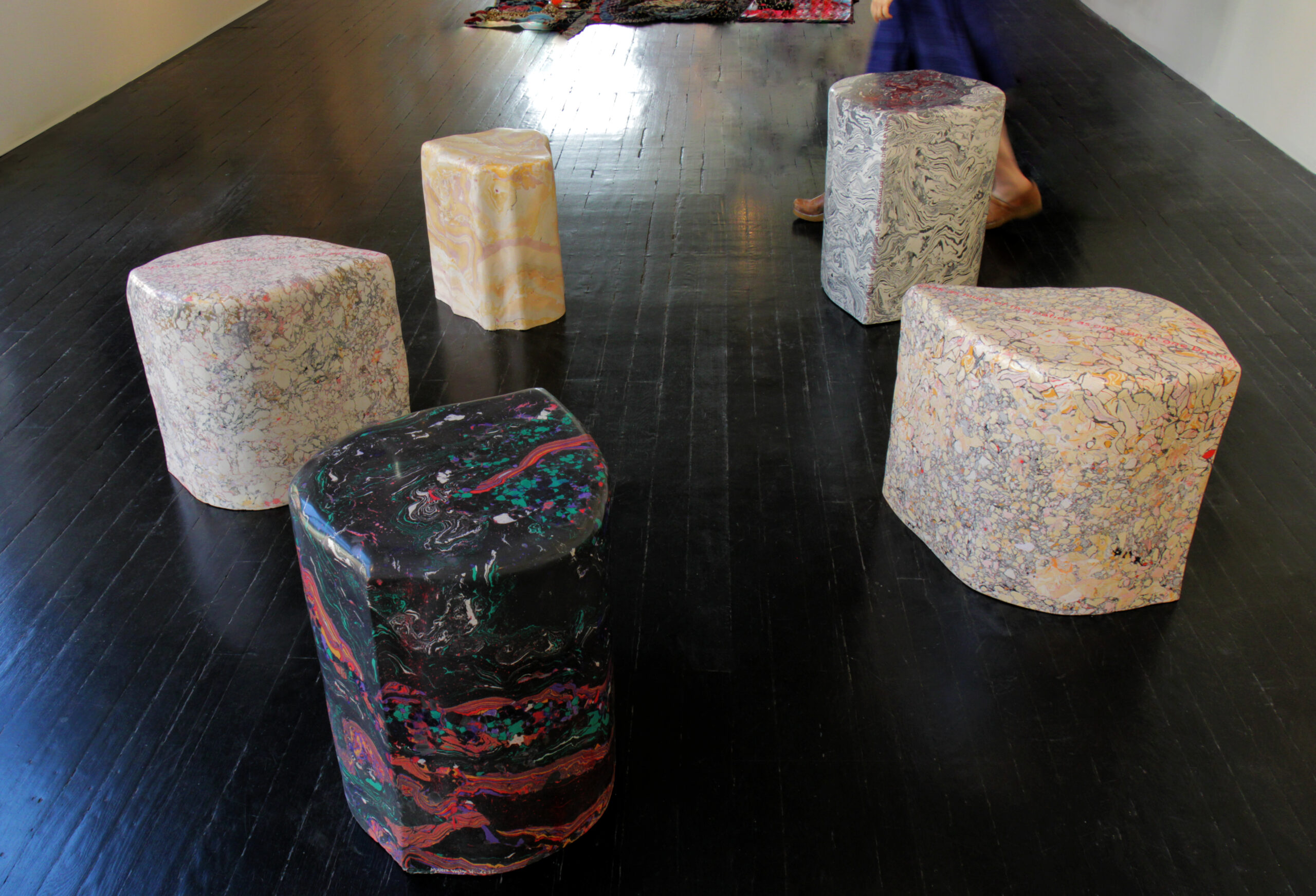
Set of seats in the exhibition
This series of low-relief three-dimensional-shaped paintings hang both on the wall and sit on the floor as objects of function like a resting place, or a pedestal. The work uses hundreds of layers of pigmented plaster pastes that are forced and fused together giving the work polychromatic optical complexity that draws the viewer into the work. The surfaces are polished to a shine and meant to be touched, often there are specific touch points in the work that draw the viewer’s touch.
My forms are borrowed from historic artists’ still lives and botanical explorations- from others’ work I borrow small elements like a single leaf or an excerpt from the text as a guide for my exploration of care work, interconnection, distance, and longing. The artists I chose were in their lives, in a relationship with another artist and this relationship informs some bodies of their work. Artist relationships that I am working with include, early Modernists Charles Sheeler and Morton Schamburg, the painter Gluck and florist Constance Spy, the painter Vannessa Bell and writer Virginia Woolf, and the polymath Hildegard of Bingen and botanist and photographer Anna Atkins, the latter was a constructed relationship by me as they did not exist in the same time. I use these relationships of care, family, love, and obsession to infuse my work with the essence of past labor, past time, and past knowledge, that is through my process, abstracted and reinterpreted.
Hammond Harkins Gallery 2023
Semidome Conductor

The subject of Melissa Vogley Woods’ paintings are folded, stacked, and stored blankets. Vogley Woods creates a metaphorical landscape of “hidden” thoughts, places and spaces — like opening boxes of stored quilts and imagining what lost stories they may contain. The folded forms are rendered so ambiguously that they shift between landscapes, still-lifes, and the human form.
These paintings are hung on top of, and in relation to, a large yet subtle wall painting. Large lavender arches derived from the architecture of the Flavian Palace in ancient Rome hover silently behind the paintings like a visual representation of background noise. The arches are dominant forms that are meant to appear when viewed from a distance, then disappear as you move closer to an individual painting. These arches were originally designed to project the emperor’s power, divinity and absolute control. I am interested in reclaiming these arches for the opposite effect: one that projects away from power and dominance and allows the “hidden and lost” forms in the paintings to dominate.
Columbus Museum of Art, 2017
Distance Loop Installation Detail
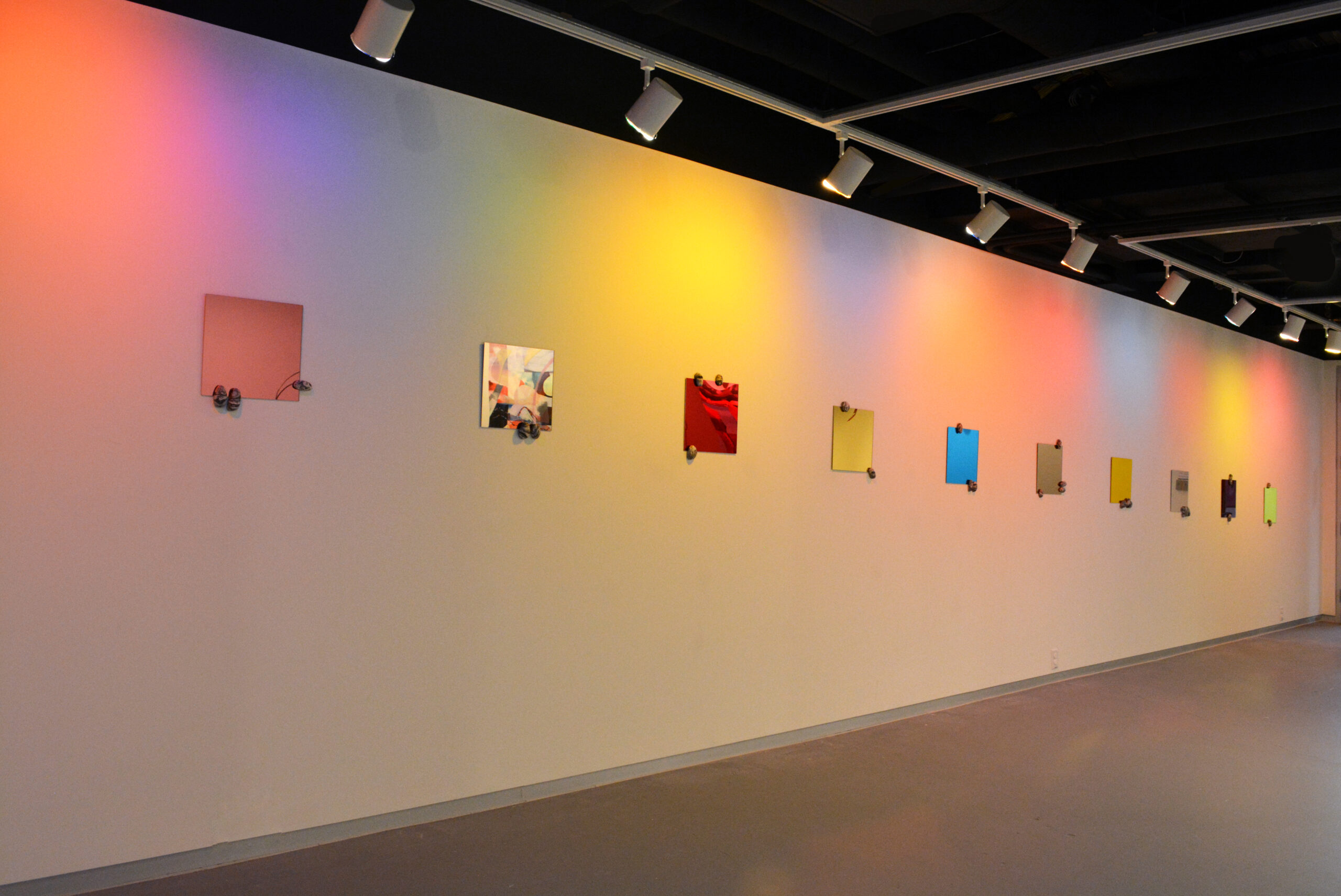
You can not go back

Painting, sculpture and mural installation
Epsten Art center Gallery Kansas City MO 2018
Painting and Video Exhibition

Angela Meleca Gallery, Columbus Ohio 2009
04/11/2024